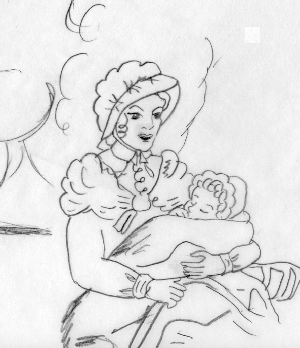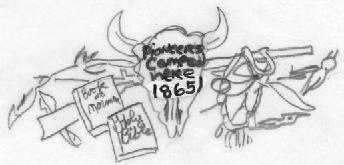Biographical sketch of Orville Sutherland Cox, continued
6 Southern Utah
In 1865 he was advised by Lorenzo Snow to move to the Muddy, a branch of the Rio Virgin, a stream running through Moapa Valley, to assist in surveying and making irrigation ditches there. The soil was very rich, but there was so much quicksand that it made it almost impossible to build a dam that would hold or to irrigate without washing away the soil. So he went south into southeastern Nevada. He thought that was the route the saints would travel going back to Jackson County, so he was that much nearer the final home. He labored there for six years, and engineered a number of dams that would hold against the floods and treachery of quicksand. They had only poor homemade plows and a few other tools to work with, and no cement or modern building material. He also built cabins and cleared and tilled the land there. In clearing the land, the ‘Mesquite’ brush root was the hardest digging they encountered. St. Thomas, St. Joseph and Overton, the 3 towns in the valley, were partly of his building. The first trip, he took with him his third wife, Eliza, and her one child, a little two year old girl; and Walter, a 13 year old son of the first wife, Elvira. The following year, after crops were in and the spring work done, he returned to Fairview after another section of his family—Mary, the second wife, and her five children. From that time on O.S. Cox’s life is a volume of tragedy and hardship. The life in the burning desert is always more or less unpleasant, and pioneering is excessively hard. And he was past fifty years old.

The Pioneer Mother
Upon a jolting wagon seat she rodeEthel Romig Fuller
Across the trackless prairie to the west,
Or trudged behind the oxen with a goad,
A sleeping child clasped tightly to her breast,
Frail flesh rebelling, but spirit never-
What tales the dark could tell of woman’s tears!!
Her bravery incentive to endeavor;
Her laughter spurring strong men past their fears.
O to her valor and her comeliness
A commonwealth today owes its white domes
Of State, its fields, its highways, and its homes—
Its cities wrested from the wilderness.
It bends in memory above the hand
That gentled, woman-wise, a savage land.
During his absence, Eliza’s little girl Lucinda, took her little pail to the creek to get some water; the quicksand caused her to slip and she was drowned. They took her out not very far down the stream, but could not resuscitate her. The poor mother, among strangers and homesick, was inconsolable in her sorrow. Walter seeing his little pet companion stricken in all her robust beauty and health, was wild with grief, and could not be comforted. After a time the neighbors concluded that Walter would die if some change did not come to get him to sleep and eat. They told Eliza of their fears for him, and so the disconsolate mother tried to hide her own grief and comfort him. It is said it was the saddest thing the women there ever saw, to see the brave mother and the boy trying to comfort each other in their loneliness. Fifty years later, it was a nightmare to Walt.

Financially the prospects were more promising than ever before. They had planted a large orchard, and a vineyard that was just coming into bearing. Then about 1871 a new line was run between the states of Utah and Nevada, which gave this section to Nevada, and Nevada demanded back taxes; and they amounted to more than their farms and houses were worth. So Brigham Young said, “Come home to Utah.” They came.